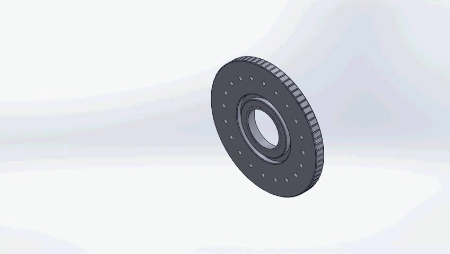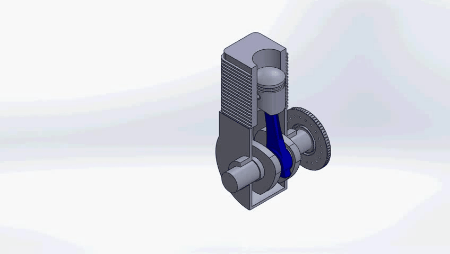THE ROBOT CALLED ICE PART2 (FLYWHEELS)
In the last article, we looked at the basics and mode of operation of internal combustion engines. Recall that in internal combustion engines, energy is produced only in the power/working stroke.
This energy is fluctuating and intermittent in nature which simply means that energy may be available when it is not needed and conversely energy may be needed when it is not available.
To make up or compensate for this fluctuation in energy, an energy storage device is needed in internal combustion engines. A device designed for this purpose is called a flywheel.
This writing introduces flywheels as a mechanical energy storage device in internal combustion engines.
WHAT WILL I LEARN?
• What a flywheel is
• Role of flywheel in internal combustion engines.
• Parameters in the design of flywheels.
WHAT IS A FLYWHEEL?

[credit: @engclinton]
A flywheel is a mechanical energy storage device. It is simply a rotating disc with high moment of inertia. I.e. flywheels have a very high tendency to resist angular acceleration.
Flywheels absorb rotational energy, and serves as a storehouse for storing this energy during the period of excess energy production (power/working stroke), and releases this stored energy back to the shaft during the period when the energy requirement is more than the supply.
In internal combustion engines, flywheels are usually attached to one end of the crankshaft to help smoothen out variations in the speed of shaft caused by torque fluctuation, thus rotating the shaft at uniform speed.
ROLE OF FLYWHEELS IN INTERNAL COMBUSTION ENGINES
Flywheels are wheels you really have to push hard to set them in motion due to their high mass.
Just as they require lot of force to set them in motion, so also they need a lot of force to make them stop so they tend to rotate forever when set in motion.
Flywheels store energy in rotating mass. Depending on the inertia and speed of the rotating mass, a given amount of kinetic energy in stored as rotational energy.
To better, understand the role of flywheels in internal combustion engines, consider the example below.
let say the torque generated during the working stroke of an engine can rotate the crankshaft for 50 revolutions and the shaft is expected to rotate for 60 revolutions in order to complete a cycle.
Recall that the flywheel is attached to one end of the shaft and by default should rotate for 50 revolutions too. However, this is not the case.
The flywheel can rotate up to 150revolutions from the same torque produced during the working stroke due to its high moment of inertia. Therefore, instead of the shaft to stop rotating after 50 revolutions, the flywheel drives the shaft for the remaining 10 revolutions by transferring some of its rotational energy to the shaft.
Flywheels absorb mechanical energy by increasing their angular velocity and delivers this energy by decreasing their velocity.
Thus, flywheels do not maintain constant rotational speed rather they control the speed variations caused by the fluctuation of the engine turning moment during each cycle of operation. See image below.

[credit: @engclinton]
BASIC PARAMETERS IN DESIGN OF FLYWHEELS
• Fluctuation of speed:
The change or difference between the maximum and minimum speeds of the shaft during a cycle is called the fluctuation of speed. Recall that a cycle comprises of the four strokes for a four stroke internal combustion engine.
Mathematically, Fluctuation of speed is given by
Fs = Wmax - Wmin
Where W is the angular speed of the shaft.
• Coefficient of fluctuation of speed:
This is an important parameter in the design of flywheels. It is the ratio of the maximum fluctuation of speed to mean speed.
Let W1 = maximum speed in r.p.m during a
cycle
W2 = minimum speed in r.p.m during a cycle
M = mean speed in r.p.m
M = (W1 + W2)/2
Cs = coefficient of fluctuation of speed
Cs = (W1 - W2)/M
= (W1 - W2)/(W1 + W2)/2
= 2 (W1 - W2)/(W1 + W2)
The coefficient of fluctuation of speed is a limiting factor in the design of flywheels because it varies depending upon the nature of service to which the flywheel Is employed.
If flywheels have a high moment of inertia, how then do we set them in motion? This question will be answered in the next article.
Thanks for reading.
References:
A Textbook of Machine Design by R.S KHUMI and J.K.GUPTA
Machine Design II by prof.k Gopinath & prof. M.M.Mayuram
Great post... But still to know about how steemstem tag works i will advise to seek for one mentor on steemstem community it will assist you in blogging science well. You need to know how to source your images and also references.
Good content buddy.
Thank you sir i will do just that!
i agree totally samest...good content.
Thanks john
I didn't know what a fly wheel was, now i do...it was nice chatting in airhawk-project as well...good luck and hope to see you more often...
Thanks to steemite that gave us the opportunity to share knowledge and learn from each other
Congratulations @engclinton! You have completed some achievement on Steemit and have been rewarded with new badge(s) :
Click on any badge to view your own Board of Honor on SteemitBoard.
To support your work, I also upvoted your post!
For more information about SteemitBoard, click here
If you no longer want to receive notifications, reply to this comment with the word
STOPIt's good to learn something new
Yea we stop learning when we die
Great
Thanks lawdralph